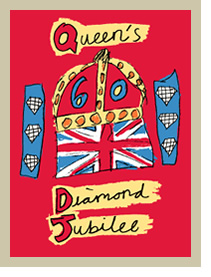 |
|
Our Parish
celebration of Her Majesty's sixty year reign takes
place on Sunday 3 June, as follows:
9.00am Said Mass with
homily (for Trinity Sunday)
Sunday 3 June is also Trinity Sunday, a Principal Feast
of the Church. Accordingly, this service is a Mass of
the Day and is dedicated to proclaiming the One God as
Father, Son, and Holy Spirit.
10.15am Jubilee Celebration
' an All Age Mass for the Parish Family
The main service of the day. Representatives from each
generation will present some of the symbols used in the
Coronation Service, we will learn about their meaning
and significance, and the value to us all of public
service, duty and committed faithfulness.
12 Noon - 2.30pm 'The Big
Lunch' |
|
As our
response to this national initiative we are holding A
Bring & Share Picnic on the green behind
St Matthew's
Church or, if the weather is inclement, in the Parish
Centre. Further details will be available shortly in
church or via the weekly notices sheet.
6.30pm Solemn Choral Evensong (for
Trinity Sunday)
7.30pm Organ Recital: 'The Queen's Musick'
Our
Director of Music, Stephen Moore, plays music
written for the Coronation Service. Admission free,
with retiring collection.
The Origins of Royal
Jubilees
The origins of Royal Jubilees lie buried in the days of
the early Pharaohs some three thousand years before
Christ. Thirty years after his accession the Pharaoh was
obliged to take part in various ceremonies to
demonstrate his continued virility and fitness to rule.
One such test was a ritual race he had to run over a
prescribed distance. In those days it was called the
Heb-sed festival. The word Jubilee is Hebrew and comes
from Yobel, which refers to the ram's horn with which
Jubilee years were proclaimed.
The concept of Jubilee is a Biblical one. In
Leviticus 25.8 onwards we read 'Count off seven
Sabbaths of years - seven times seven years - so that
the seven Sabbaths of years amount to a period of
forty-nine years. Then have the trumpet sounded
everywhere on the tenth day of the seventh month; on the
Day of Atonement sound the trumpet throughout your land.
Consecrate the fiftieth year and proclaim liberty
throughout the land to all its inhabitants. It shall be
a Jubilee to you.
The Book of Leviticus goes on to advocate the return of
land to the rightful owners and the freeing of slaves in
the Jubilee year. Whether this ever happened in ancient
Israel is disputed. The concept, however, lay behind the
recent successful Jubilee Campaign to free developing
countries from international debt.
Medieval Popes also adopted the idea of a Jubilee and
this has developed into what the Roman Catholics call
Holy Year. The first was proclaimed by Pope Boniface
VIII in 1300. The main attraction was the indulgence
gained by anybody who put in an appearance in Rome
during Jubilee year.
Early English monarchs had few opportunities to
celebrate Jubilees. Life was so hard and their
profession so precarious that few of them attained the
age of 50, still less reigned for 50 years.
In England only two early monarchs marked their Jubilees
- Henry III in 1265 and Edward III in
1377, so the first Jubilee to compare with the
forthcoming Diamond Jubilee is that of King George III
in 1809. Henry III and Edward III both
celebrated their Jubilees with celebrations consisting
principally of religious observances, pardons to certain
offenders and criminals, and other such acts of piety.
In modern times, Royal Jubilees have been celebrated
elsewhere in the world. The late Emperor Hirohito of
Japan celebrated fifty years in 1976, while the Silver
Jubilee of Queen Juliana of The Netherlands was
marked in 1973, that of the late Prince Rainier of Monaco
in 1974, and that of the late King Baudouin of
Belgium in 1976.
To find out more, please visit the
Official Jubilee website
|